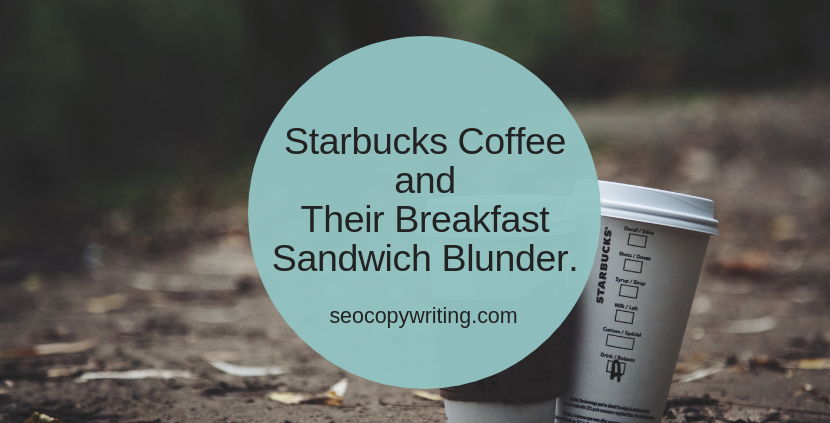Starbucks Coffee and Their Breakfast Sandwich Blunder
Don’t get me wrong. I adore Starbucks coffee.
My friends tease me about how, at every conference, I drag them all over creation to find the nearest Starbucks (and no, in my perpetually jet-lagged state, Dunkin’ Donuts coffee just won’t do.)
Every day around 6am, I walk to Starbucks and get my morning fix.
Heck, I’m even married to a man who works for Starbucks corporate.
If that’s not brand loyalty, I don’t know what is.
But here’s the problem. In a recent in-store promotion, the Starbucks writers fell into the trap that so many copywriters do – they let a headline get cutesy and take a back seat to substance.
I was waiting for my afternoon coffee when a customer grabbed the latest in-store promotional flyer for breakfast sandwiches. After a quick glance, she looked up and said, “You know, this headline doesn’t even make sense.”
I grabbed my own flyer (as did another customer) and realized she was right.
The headline: “Wake up to a new toasty warm and savory delicious.”
I wondered if this was a fill-in the-blank statement. “Hmm, I can ‘wake up to a new toasty warm and savory delicious’…what?”
My imagination started whirling on the possibilities that had absolutely nothing to do with food. Sure, the photo clearly showed a breakfast sandwich. And the subheadline (which clarified the statement but didn’t grammatically flow) did say “Starbucks Piadini, Wrap and Breakfast Sandwiches.” But the freestanding headline statement – the first thing I viewed when I read the flyer – was all fluff and no substance.
What’s worse, the headline stopped three customers in their tracks. We weren’t discussing the creamy hot goodness of our extra-hot soy lattes. Nor were we soaking up the Starbucks vibe. Instead, we were connecting over bad copy— and wondering why the heck a big brand could make such a strange error.
This is what happens when copywriters substitute good, solid writing with fluffy gimmicks.
Now, let’s talk about what could have worked…
Really, it could have been as simple as making the headline and subheadline flow. Such as:
“Now, you can wake up to a toasty warm and savory delicious Starbucks Piadini, Wrap, or Breakfast Sandwich”
This headline makes much more sense. I deleted “new” from the copy (typically a marketing power word) and replaced it with “now” (also a power word) to encourage the call to action
I also added the word “you,” to personalize the copy. This added two words to the original headline.
Starbucks could reinforce that this is a new product – plus hammer home the “healthy options” benefit by improving the subheadline:
Now, you can wake up to a toasty warm and savory delicious Piadini, Wrap, or Breakfast Sandwich…
…New healthy breakfast choices from Starbucks
There are scads of ways to improve the copy (and I bet readers can come up with their own improved versions.) However, the bottom line is this: someone at Starbucks corporate should have nixed this headline before it hit the streets.
In general, Starbucks has had historically good copy that’s emotion-rich and grammatically correct. However, a verbiage blunder like this does nothing but reflect negatively upon their brand.
(Update — Starbucks’ messaging has improved so much since I wrote this article.)
Does a company’s messaging make you scratch your head and say, “I don’t get it?” What’s an awesome example of benefit-packed marketing? Leave your comments below!




And if the economy continues to go a little further south how many people will be saying, “I can save xxx a month by not going to starbucks”?
I’d actually expect them to start up a larger loyalty program soon if they are smart.
You do have to wonder…at $4 a latte (at least what I order,) it can be a dreadfully expensive habit… :)
Just a thought..
If the line had been gramatically correct in that ad, would it have “stopped three customers in their tracks”? Isn’t that exactly what you want people that see the ad to do? To have it stuck in their head and make it so impossible to ignore that they engage in conversation with perfect strangers about it, or even write a blog entry about it? Seems to me they got exactly what they wanted.
Hehe, very interesting perspective…Good point!
At the end of the day, the questions to ask are:
1. Did the conversation that the three customers have positively enhance the brand experience? Was it neutral (as in “What a stupid ad – they could have done better, but it doesn’t change my opinion/behavior.) Or did it detract from it? And…
2. Did it make people want to try their breakfast sandwiches? Was the campaign successful?
Thanks for your comments!
That would make people think and figure out what it actually means. This would mean you are thinking about Starbucks for a pretty long time to come! It could also be like what you pointed out in the article.